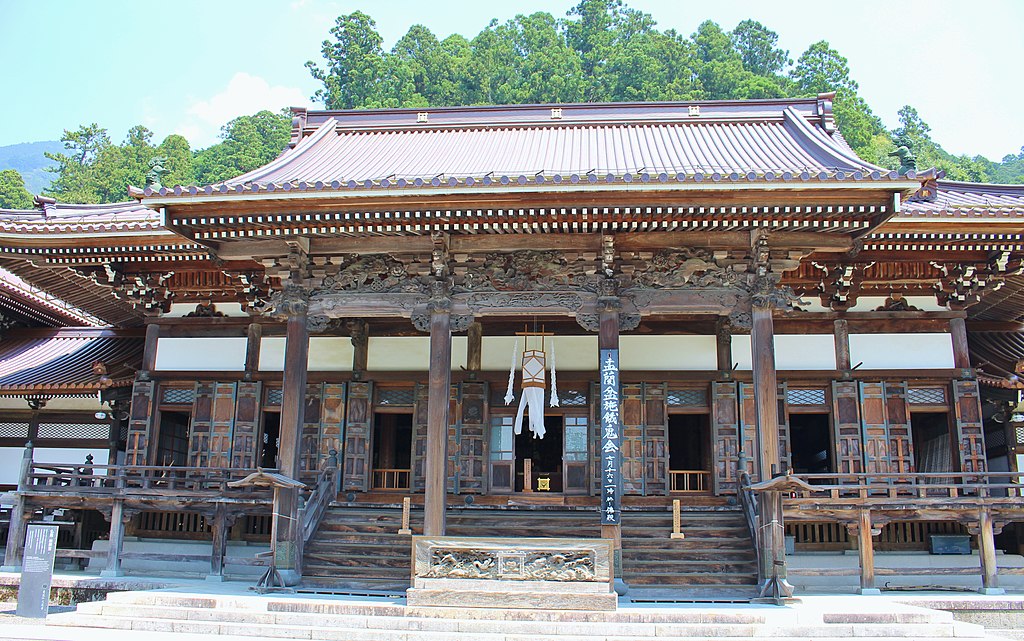The Formative Years (1222-1253)
There is continuity between the Pure Land and Nichiren schools, as they share similar basic characteristics, as well as a conflicted relationship, as the Nichiren school originated in opposition to the Pure Land school, at least during the elaboration of the former by its founder. Both schools developed against the backdrop of the Final Dharma age (mappo), at a time when Buddhism was believed to be in decline, so both dedicated their teachings to those who were unable to follow the “Path of Self-Perfection,” (i.e., the path relying on one’s own power) and worked out a practice consisting in the exclusive chanting of a mantra. At the same time, Nichiren’s career was motivated from beginning to end by a criticism of Pure Land teachings which had become very popular during his lifetime, and caused the Lotus Sutra to be “deprived of its former preeminence.” Even the shogunate had fallen under the spell of Pure Land! Along with many people in the thirteenth century, Nichiren interpreted the unprecedented series of calamities, natural and human made, that beset Japan, as “signs of eroded devotion to the Lotus Sutra” (Thomas Kasulis).
Jacqueline Stone devotes a long and detailed chapter to Nichiren’s teachings in her book on Original Enlightenment. This is not to say, however, that she studies Nichiren’s thought through the lens of original enlightenment. The texts attributed to Nichiren where he discusses original enlightenment have been claimed by one scholar to be forgeries by Nichiren’s disciples during the Muromachi period. For now, she says, “since these problems of authorship are unlikely to be resolved in the near future, if at all, it is hard to assess just how far Nichiren appropriated Original enlightenment ideas.” In her view, “Nichiren’s concern was to declare the exclusive validity of the Lotus Sutra in the Final Dharma age and to rebuke those who lacked faith in it. He himself created and inhabited a hermeneutical universe in which every significant event of his age was interpreted from this perspective … Whether people are or are not enlightened inherently was not his central concern.”
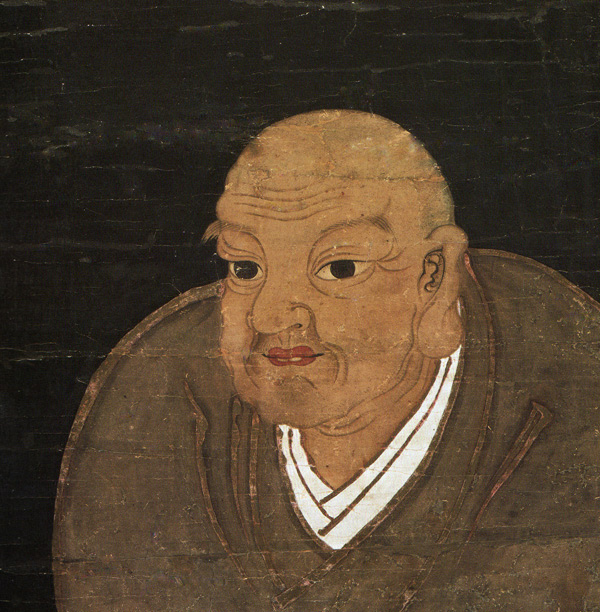
Nichiren was born in 1222 in a fishing village of the Awa province, now the Chiba Prefecture, in “the eastern provinces, despised as culturally backward by people of the Kyoto region.” Unlike Saicho, Kukai, Honen, Shinran, Dogen, and other Buddhist leaders in ancient Japan, Nichiren, whose birth name was Zennichimaro (variously translated as “Splendid Sun” and “Virtuous Sun Boy”), did not belong to the aristocracy. Stone writes: “He alone was of common origins. In later life, he would describe himself as ‘the son of lowly people’ … or the child of a fisherman.” She adds that recent scholarship suggests that his father may have been an official in charge of administering the exercise of fishing rights. Still, “Nichiren’s marginal position as a person of low social position from a remote part of eastern Japan would profoundly influence both his career and his thought … [it] imbued his teaching with a distinctly subversive edge. When challenging the monks of prominent temples, he would assert that religious authority stemmed not from birth or position, but from commitment to the Lotus Sutra.”
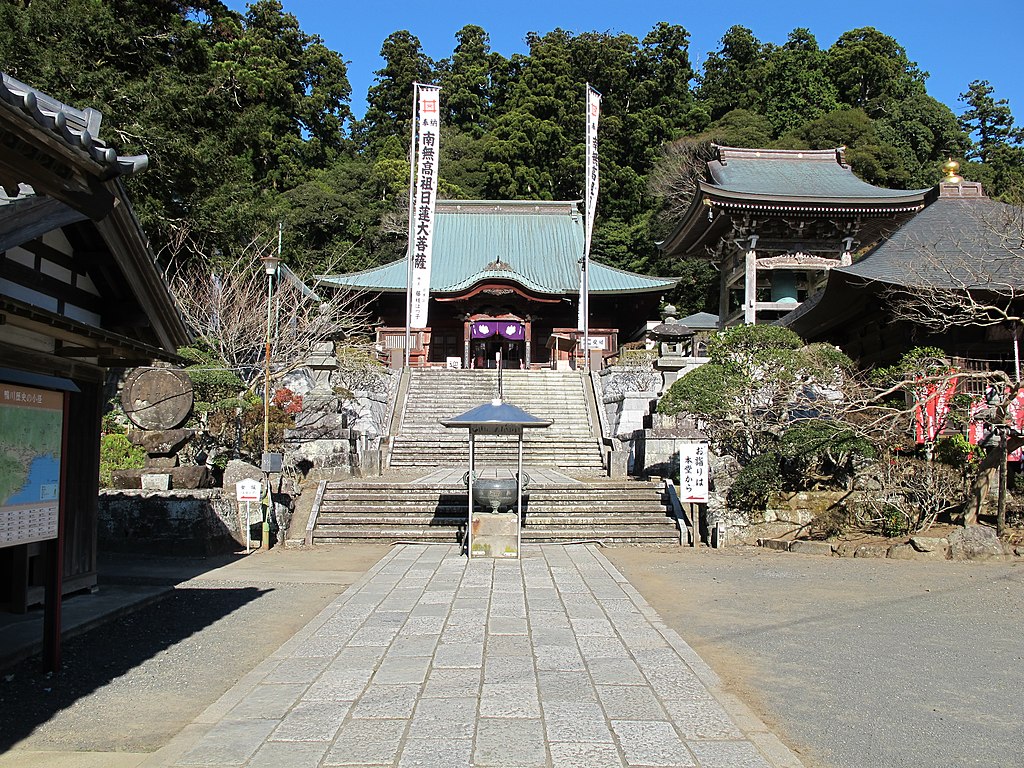
At the age of twelve, Stone writes, Nichiren entered the Kiyosumidera (or Seichoji), a local temple believed to be a Tendai temple, “though it may have been a centre for esoteric practice not specifically affiliated with either Tendai or Shingon. He was ordained there at age sixteen by his teacher Dozen-bo.”

As an adolescent, Nichiren “possessed an unusually strong desire for knowledge.” He “wrote that he prayed before an image of the bodhisattva Kokuzo (Skt Akasagarbha) … to become the “wisest man in Japan,” echoing Kukai who, in his youth, had recited the mantra of Akasagarbha, also known as the Morning Star mantra, one million times. Then, “having exhausted the intellectual resources of his rural temple, Nichiren set out for the country’s major Buddhist centers, first in Kamakura, and later in the region of the imperial capital – Mt Hiei, Onjoji, Koya, Tennoji, and various temples throughout the many provinces. In Kamakura he is thought to have studied the Pure Land teachings and Zen.” His earliest extant work, the Kaitai sokushin jobutsu gi (The meaning of the precept essence and the realization of Buddhahood with this very body), written in 1242 … contains an attack on Honen’s Pure Land doctrine, especially the notion of seeking a pure land apart from one’s own body and mind … This,” Stone asserts, “is the earliest notice of his lifelong antipathy to Pure Land faith and practice, that of Honen in particular.”
It is said that when he was on Mt Hiei, his accent would have marked him as a native of the despised eastern provinces, and he would have been excluded from the circles of initiates that gathered around the leading masters there. That exclusion would have led him to “rely on the Dharma [that is, on written documents] and not upon persons.”
During his twenty years of travelling from temple to temple, Nichiren was exposed to a spectrum of Buddhist practices and institutions including the Tendai and Shingon esoteric practices on Mt Hiei and Mt Koya, as well as the practices of the new Pure Land lineages of Honen’s disciples, the beginnings of an independent Zen, and the religious practices of a variety of hijiri (holy men), both itinerants and recluses. “One concrete piece of data that survives concerning Nichiren’s studies during this period is his transcription, done in Kyoto in 1251, of the Gorin kuji myo himitsu shaku (Secret interpretation of the five-elements stupa and the nine-letter mantra) by the Shingon master Kakuban (1095-1143). This work interprets Amida Buddha and the Pure Land from the standpoint of Tomitsu, or Shingon Mikkyo.”
Stone says that, in his later writings, Nichiren suggests that he formed his exclusive commitment to the Lotus Sutra during this period of travel and study. This commitment, based on a formidable knowledge reflected in the more than 500 extant works attributed to him, deepened through the many twists and turns of a rather turbulent life, as he challenged both the political and religious authorities of his time.
From Intense Study to “Adversarial Position” (1253-1261)
In 1253, at the age of thirty-two, and after a twenty-year period of studies and practice in Japan’s major Buddhist centres, Nichiren passed from study to action. Having returned to the Kiyosumidera/Seicho-ji temple where he had trained as a young monk, he, according to Nichiren’s later writings, publicly declared his intention to found a new school – the school of True Buddhism. “According to later hagiographies, on this day, Nichiren rose before dawn, climbed the hill Takakamori behind the temple, and facing the morning sun as it rose above the ocean, chanted ‘Namu-myoho-renge-kyo’ for the first time. On that same day he renamed himself “Nichiren (nichi means sun, ren means lotus).” At noon he preached his first sermon.” This first sermon presumably included a criticism of the nenbutsu. It was reported to the local bakufu-appointed steward, Tojo Kagenobu, an ardent Pure Land follower [the bakufu was the military government headed by the shogun, based in Kamakura, which held effective power in Japan between 1192 and 1868]. Kagenobu sent armed officers to arrest Nichiren, but Dozen-bo, Nichiren’s former teacher, had two senior monks help him escape.
This, at least, is the traditional narrative for Nichiren’s rather dramatic declaration for the establishment of True Buddhism. Nichiren had expected a pushback and, even though he had escaped on that day, “the growing hostility of Kagenobu and the Pure Land faction at the Kiyosumidera eventually forced him to leave.” And, when eleven years later, he came back to visit his mother, Nichiren “was ambushed and nearly killed by a band of Kagenobu’s men.”
Stone believes that, at this early stage, Nichiren’s aim had simply been to “revive central emphasis on the Lotus Sutra within the Tendai tradition.” This is, at least, what he focused on when he settled back in Kamakura, and started to attract followers, both monks and lay people.
Stone writes that Nichiren “made drawings of two visions that had appeared to him, in the first month of 1254, of the “living forms” of the esoteric deities Aizen Myoo and Fudo Myoo … The ‘seed characters’ – Sanskrit letters representing a particular deity – for these figures would later appear on a mandala that Nichiren devised, written there in Siddham, the medieval Sanskrit orthography.“
It is around this time, also, that Nichiren encouraged his disciples to chant the daimoku. Namu-myoho-renge-kyo is the Sino-Japanese pronunciation for Miao-fa-lien-hua ching, the title of the Chinese translation of the “Saddharma-pundarika-sutra” made by Kumarajiva in 406, and regarded as authoritative throughout Asia. Namu, a transliteration of the Sanskrit namo– (from namas), is an expression of devotion, veneration, praise, or the taking of refuge.” Use of this phrase “is attested as early as the 9th century … Nichiren, however, was the first to define the daimoku as an exclusive practice and to provide it with a doctrinal foundation.” The definition of the daimoku as an exclusive practice, which obviously reflects the influence of Honen’s exclusive practice of the nenbutsu, did not, however, come for Nichiren until many years later. Again, at this early stage, Nichiren presented it as “an alternative for ‘ignorant persons’ unable to perform the introspective contemplation on the ‘three thousand realms in a single thought-moment’, which those ‘who have the resolve’ are encouraged to pursue.”
Stone notes that “the year 1254, when Nichiren arrived in Kamakura, saw the beginning of a grim wave of calamities: drought, storms, famine, epidemics, earthquakes, fires, and ominous astronomical portents. The era name was changed four times between 1256 and 1260, in an attempt to stem disasters by renewing the cycle of time.” In pre-scientific times, people believed that such unprecedented levels of misery had their roots in their failure to honour their gods, or abide by their religious texts. Nichiren writes: “When prayers are offered for the peace of the land and still the three disasters occur within the country, then one should know that it is because an evil teaching has spread.” The “evil teaching” Nichiren saw as Honen’s exclusive nenbutsu, which had only recently spread throughout the land and “closed off the direct path of the Lotus and esoteric teachings.” Although the Pure Land school had origins going all the way back to the origins of Buddhism in India, in Japan itself it was relatively new, whereas the Lotus Sutra which Prince Shotoku, the founder of the Japanese state, had selected and commented on, had been revered as the main text of Japanese Buddhism since the 7th century.

In 1260, Nichiren went one step further on his way to what Stone calls his “adversarial position” when he wrote his memorial Rissho ankoku ron (Treatise on establishing the right [teaching] and bringing peace to the land) and submitted it via an intermediary to Hojo Tokiyori, the former regent to the shogun. Stone explains that, “though officially retired, Tokiyori was then the most powerful figure in the bakufu. In this treatise, Nichiren argued that the protective kami had abandoned the nation because the people as a whole had “turned their back upon the right – the supreme teaching of the Buddha’s lifetime, the Lotus Sutra – and ‘given themselves to evil’, which he identified, again, with Honen’s exclusive nenbutsu … Just as the sutras described, there had been violent and unseasonable storms, crop failure, famine, epidemics, and ominous portents in the heavens. If the situation were not rectified, he said, based on these scriptural predictions, two further disasters could be expected to occur – the ‘calamity of revolt within one’s own domain’ and ‘the calamity of invasion from foreign lands’.”
This public remonstration was not without consequences. “Nichiren was soon challenged to debate by the leading Jodo prelates in Kamakura … By Nichiren’s account, his opponents were unable to respond after only a few exchanges. He writes that their lay followers then repeatedly attacked him and spread slanderous rumors about him to persons in authority. A mob attacked his dwelling seeking to kill him, and he was forced to leave Kamakura temporarily. The year after he submitted his memorial, the bakufu had him arrested and exiled to the Izu peninsula.”
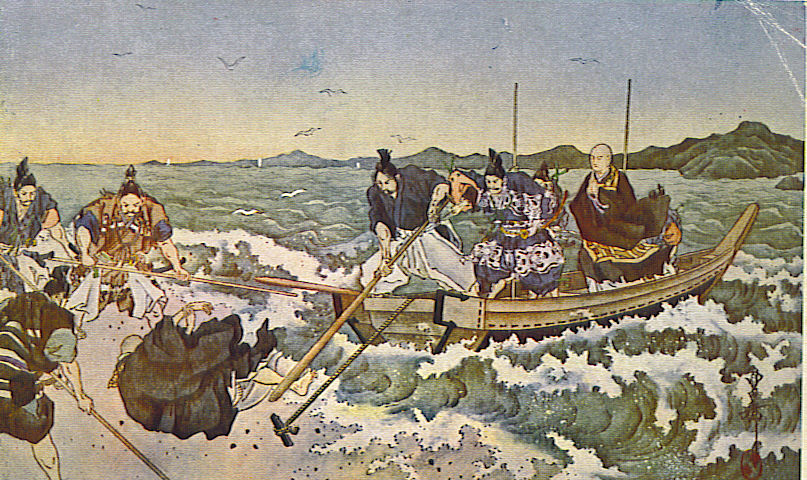
Exile On The Izu Peninsula (1261-1263)
More, perhaps, than the thought of Buddhist leaders such as Saicho, Kukai, Honen or Shinran, Nichiren’s thought was shaped by the circumstances prevailing in Japan during his lifetime – an apparently endless series of calamities – and by the events of Nichiren’s career, in particular his “adversarial position” with regard to political power. This is why the development of Nichiren’s thought needs to be placed in the historical context of its elaboration.
For example, Jacqueline Stone points out that, when Nichiren submitted his memorial Rissho ankoku ron (Treatise on establishing the right [teaching] and bringing peace to the land) to Hojo Tokiyori, he “clearly saw himself as a successor to Myoe and other representatives of the Buddhist establishment who had written rebuttals to Honen’s Senchakushu and appealed to the court to suppress the exclusive nenbutsu for the sake of the national welfare.” Nichiren’s own treatise, however, was not regarded in the same light. Stone explains that, since Myoe was a representative of the Buddhist establishment, he had “conflated the “country” with the “imperial law”; “nation protection” in [his] eyes was equated with protecting the system of aristocratic rule grounded in the authority of the emperor, the retired emperor, and the court. In Nichiren’s eyes, the country and the rule of the court and aristocracy were entirely different matters … The ‘land’ in his treatise is the external world, nondually related to sentient beings and capable of positive transformation through their faith in the ‘one-vehicle’. To ensure the spread of the one vehicle, the ruler’s support is indispensable, but his role is ‘relativized by his responsibility,’ in Nichiren’s eyes, to discern the True Dharma from false teachings and protect the former while suppressing the latter.” In other words, for Nichiren the authority of the True Dharma, which he identified with the Lotus Sutra, exceeds that of the emperor, the court, and the shogun, and the latter, who held effective power, had a duty to protect it. One could say that, because he was not a member of the aristocracy, Nichiren could not assert authority by birth or position, and instead asserted it through commitment to the Lotus Sutra. Likewise, when we look at ways to avoid the impending disasters looming for us in the coming decades of the 21st century, don’t we regard our governments as having a duty to protect the environment, which implies that we see the authority of science as exceeding that of politics?
Stone, however, notes that “had Nichiren not publicly attacked Honen’s teaching and come into conflict with the bakufu, his following might have remained simply another branch of medieval Tendai … However, his failure to win an official hearing, followed by the sentence of exile, forced him into an ‘adversarial position’ from which he would begin to define his religion over and against that of the ruling elites. Of low status from the outset and now under criminal sentence, Nichiren would increasingly articulate his message from the standpoint of someone on the margins in challenge to the center.” The “adversarial position” into which he was “forced” caused Nichiren to harden his doctrine further than he may have wished to, in a bid to strengthen its authority. Also, whereas earlier Buddhist theorists had aimed for the liberation of individual practitioners – helping them to attain enlightenment -, Nichiren’s aim went beyond a dedication to helping individuals: it was also to save the country from calamities, given his belief that neglect of the True Dharma was at the root of these unprecedented disasters. The True Dharma was for him what ecological science is for us today.
Nichiren’s exile in Izu provided Nichiren with a new opportunity for studies. His focus was now firmly on the Lotus Sutra, with which he developed a personal connection. He “began to refer to himself as the gyoja – practitioner or votary – of the Lotus Sutra. In contrast to the jikyosha, one who ‘holds’ the sutra and recites it, the ‘gyoja’ for Nichiren was “one who lived the sutra through one’s actions, experiencing in one’s own person the great trials that it predicts. His later writings would call this ‘reading with the body’ (shikidoku).”
Nichiren’s Izu writings also focus on the characteristics which justify the Lotus being regarded as the “supreme teaching.” These are called the five principles (gogi).
1) The teaching: Following Zhiyi’s Tiantai classification, Nishiren assigns the Lotus to the last period of the Buddha’s life, and asserts that “all other, earlier sutras are provisional while the Lotus alone is true.” Along with Zhiyi also, Nichiren “saw the superiority of the Lotus Sutra as lying in two teachings unique to this scripture and identified respectively with the trace and origin teachings – specifically, with the second chapter (‘Skillful Means’) and the sixteenth (‘Fathoming the Lifespan of the Tathagata’).” Unlike other Mahayana sutras, the Lotus asserted that even followers of Hinayana could attain Buddhahood. Another key feature of the Lotus was “the revelation of the Buddha’s enlightenment in the remote past. According to the sutra, all other Buddhas were merely emanations or manifestations of Sakyamuni. Moreover, Sakyamuni is said to have displayed himself as entering final nirvana as a ‘skillful means’ to arouse people’s longing for his teaching, but in reality, he is ‘always here in this Saha world’. [Also] the Buddha’s enlightenment in the far distant past was widely understood in Nichiren’s time to mean that the Buddha is eternal and constantly abides in this world.”
2) Human capacity (for achieving salvation through a particular teaching): “For Nichiren, as for Honen, ‘capacity’ was to be understood in universal terms;” both men “maintained that all persons can be saved through a single teaching.” Not because the Lotus Sutra was easy, but because it was “true.” Nichiren asserted that “the more true the teaching, the lower the stage of the practitioners it can bring to enlightenment.”
3) The time: Honen had said that the Lotus Sutra was too profound for people of the Final Dharma age. Nichiren disagreed, and said instead that “the Buddha specifically intended the daimoku of the Lotus Sutra for the Final Dharma age; thus this age is the very time when the daimoku is destined to spread.”
4) The Land or Country: “Nichiren argued that the country of Japan [was] related exclusively to the Lotus Sutra” and complained that Mt Hiei’s scholars “had contaminated it with Mikkyo, Pure Land, and other ‘inferior’ teachings.”
5) Sequence of Dharma Propagation: “It was inappropriate, in Nichiren’s view, to teach provisional Mahayana or Hinayana teachings in Japan, where the true Mahayana teaching (i.e., the Lotus) had already been established by Saicho.”
It is undeniable that Nichiren’s two years of exile in Izu hardened his position considerably. Stone says that his writings “show a growing concern with the evil of ‘slanderer of the Dharma’, a sin elaborated in detail in a number of Mahayana sutras but which Nichiren understood as willful disbelief in or rejection of the Lotus Sutra.” He saw it as “exceeding a thousand times the offense of killing one’s mother, father, or an arhat. Thus the practitioner of the Lotus [had] a duty to rebuke slander, whatever the personal consequences, including loss of their own life.”
Exile on the Island of Sado and Reclusion on Mt Minobu (1263-1282)
Nichiren was pardoned from his sentence of banishment in 1263, but did not immediately return to Kamukura. Instead he engaged in preaching, paid a visit to his mother and former teacher in the Awa province, during which he was injured, and a man in his party killed, during an ambush by Tojo Kagenobu’s men. When he finally returned to Kamakura in 1268, envoys sent by Khubilai Khan had already warned that, should Japan refuse to acknowledge the suzerainty of the Mongol empire, it would be subdued by force of arms. “Nichiren and his community were emboldened by the fact that the prophecy made in the Rissho ankoku ron of ‘invasion from foreign lands’ seemed about to be fulfilled. His following grew, and Nichiren took the opportunity to repeat his memorializing of top officials. He also began to challenge actively the teachings represented by those monks of the major temples in Kamakura who enjoyed the patronage of the Hojo.” These included Zen and Shingon temples, as well as Pure Land centres. Stone writes: “Nichiren knew that he was courting danger and wrote to a close follower that he had resolved to give his life for the Lotus Sutra.”
Among the masters he challenged was Ryokan-bo Ninsho, an esoteric ritual specialist who was widely revered among the nobility for his virtue and charitable activities. Stone says that, according to Nichiren’s account, “Nichiren sent Ninsho a challenge to produce rain within one month: if Ninsho succeeded, Nichiren would become his disciple; if he failed, Ninsho should embrace the Lotus Sutra. When the rituals conducted by Ninsho and his hundreds of disciples failed to produce rain, Nichiren sent him another letter asking how Ninsho expected to achieve the difficult goal of Buddhahood, when he could not even accomplish the easy task of producing rain. Chagrined, the humiliated cleric then prompted bakufu authorities to move against Nichiren.”
In December 1271, Nichiren was arrested and sentenced to exile on the remote island of Sado in the Japan Sea, possibly as part of a move to eliminate unruly individuals at a time when the bakufu was mobilising for the defense of the country against the Mongols. According to Nichiren, the plan had been to have him beheaded, and he had been taken to the execution grounds, but for some reason his life was spared. Stone says that later hagiographies “elaborated on the drama,” claiming that he was indeed beheaded, and “this is his spirit that had come to the province of Sado.”
It is on Sado Island that Nichiren produced his most important writings, including the Kaimoku sho (Opening of the eyes) and the Kanjin honzon sho (The contemplation of the mind and the object of worship).
At the beginning of 1272, another prediction he had made in the Rissho ankoku ron – that there would be “rebellion within one’s domain” – came to pass as the half brother of the shogunal regent attempted to usurp the regency, and fighting broke out in Kyoto and Kamakura.
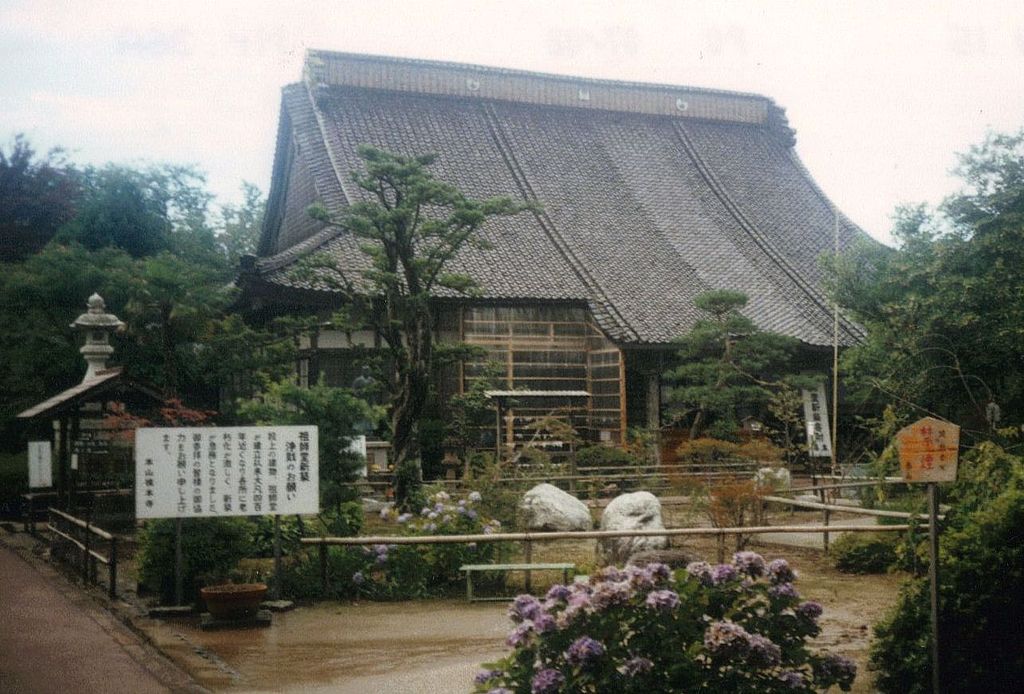
During the Sado period, Nichiren focused more than ever on the Lotus Sutra, which he sought to reinterpret in a way distinct from that of Tendai. One of his most significant moves was his identification with the Bodhisattva Superior Conduct. This Bodhisattva is one of the bodhisattvas who, in the Lotus, sprang from the earth. Stone explains that these were “‘the Buddha’s ‘original disciples’; that is, they are followers not of the historical Sakyamuni who attained enlightenment under the bodhi tree, but of the original Buddha, enlightened since the inconceivably remote past … Nichiren was [thus] claiming a direct connection to the original Buddha.” It is on the basis of this claim that “Nichiren elaborated three aspects of this ‘secret Dharma’ – the daimoku, the object of worship, and the ordination platform.”
Stone writes: “Up until this point, Nichiren had merely asserted the superiority of the Lotus Sutra over all others; now he turned his attention to its latter fourteen chapters. The teaching of the three thousand realms in one thought-moment is found only in the origin teaching of the Lotus, hidden in the depths of the text of the “Fathoming the Lifespan” chapter. Where Chih-i had derived the doctrine of the three thousand realms in one thought-moment from the trace teaching, specifically from the “Skillful Means” chapter, Nichiren now identified it with the original Buddha. This was not entirely a novel move… Nichiren’s emphasis on the origin teaching was distinctive, however, in that he defined it as uniquely related to the Final Dharma age. For him, the origin teaching mediated a ‘great secret Dharma’, embodied as the five characters of the daimoku, that had been transferred by Sakyamuni Buddha to the bodhisattvas who had emerged from beneath the earth, especially for the mappo era.”
Following this reinterpretation, the daimoku could no longer be seen simply as a practice for ignorant people. As bestowed by the bodhisattvas who sprang up from the earth, “it became the vehicle of direct access to the Buddha’s enlightenment.”
In 1274, after two and half years, a pardon was issued. Hei no Yoritsuna, the man who had arrested him, sent for him as he wanted to know when the Mongol attack might be expected. “Nichiren replied (accurately, as it turned out) that they would strike within the year. He also admonished, as he had at the time of his arrest, that only reliance on the Lotus Sutra could forestall the disaster.” This time, Nichiren readily returned to Kamakura, though not for long. Stone says that “a biography written a few decades after Nichiren’s death says that he was offered bakufu patronage if he would add his prayers to those offered by other temples and shrines, but he refused.”
That same year 1274 saw him once more on the road. He had decided to become a solitary wayfarer. He made his way to Mt Minobu, to visit one of his followers, intending only a brief stay. In fact, his temporary stay lasted nine years as a community of sixty disciples formed around him. “More than half his extant writings are from this period.”
“Exhausted by years of privation, Nichiren fell ill in 1282 … he died en route at Ikegami (now a suburb of Tokyo) … to visit the hot springs in Hitachi.” He was sixty years old. “Though he had never won official recognition for his teaching, he seems to have died with the confidence it would one day happen.”
Sources:
Thomas P. Kasulis – Engaging Japanese Philosophy
Jacqueline I. Stone – Original Enlightenment and the Transformation of Medieval Japanese Buddhism
